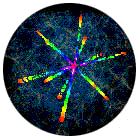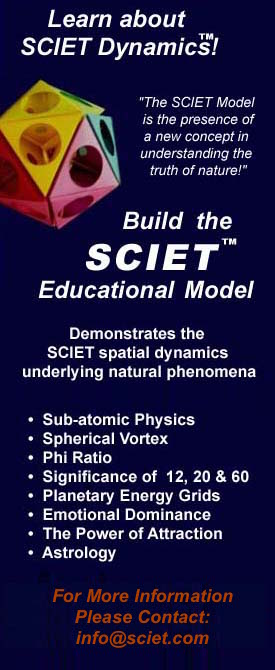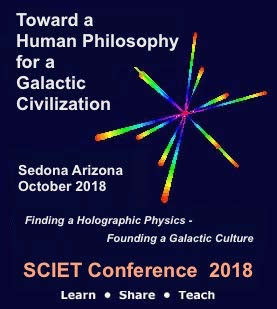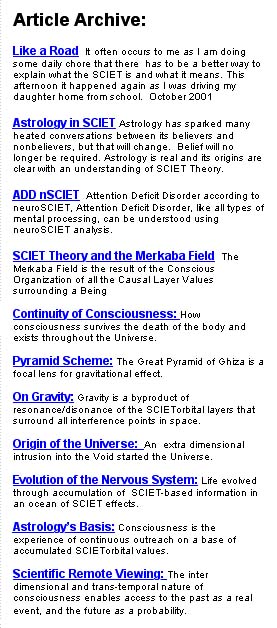|
ADD nSCIET
Attention Deficit Disorder according to neuroSCIET
Attention Deficit Disorder, like all types of mental processing, can be understood using neuroSCIET analysis. In the context of neuroSCIET, Attention Deficit Disorder can be understood to be a natural selection enhancement of the visual thinking abilities of humans.
Understanding that it is a hereditary quality, we have to ask ourselves why nature would re-enforce a ``disorder". The answer is that it does not. ADD is not a disorder at all, but an enhancement of the visual thinking capabilities that has served people extremely well throughout history. Human society has roles for all types of people, and the qualities of being energetic and quick to respond to visual stimuli have aided the survival of hunter-gatherers from the beginning. History had no criticism of this quality until the advent of mandated public education, which forced the active visual learners into an institutionalized program of teaching in classrooms where learning was restricted to sedentary linear processes.
It has been known since the beginning of classroom instruction that many very bright people were not good students, but found great success in professional fields where they could learn while being active.
That people who have the symptoms of ADD are today termed ``diseased" is an artifice of our approach to medicine and and its commercialization. Legal restrictions on the use of the drugs used to enhance concentration make it mandatory that those who use them have a ``disease". It is not a disease and this approach is socially damaging to the students and undermining to our society. Restriction on the availability of the concentration enhancing drugs makes sense, but treating the ADD symptomology as a disease does not.
The ADDers are different from the majority of students, yes, but that difference is not a problem except for the expectations of those who would have them sit still and do as they are ``told". They do not remember sounds very well and verbal instructions are often forgotten within seconds. Individuals with this condition have always been part of society and have prospered in apprenticeship and learn-by-doing environments. Thousands of years of human society without written language made them honored leaders in the crafts needed to survive and prosper in hunter gatherer and agricultural communities. They do not need medicine, they need a different set of expectations and method of learning suited to their abilities. Drugs to enhance concentration can be beneficial, but without an understanding of the students real capabilities and needs, they are like damming a river with no outlet.
NeuroSCIET
SCIET Dynamics is a study of field effects that compound into ever more complex systems. It has its own type of descriptive math that illustrates the relationship of the brain to the mind that is termed neuroSCIET. NeuroSCIET can provide an enhanced awareness of mental functioning that can be used to create effective educational models of ADD students.
The most important insight is regarding the nature of visual versus auditory functions. Research has recently established that the cells use a type of photonic pulse to communicate. We can generalize that the use of light to process information is the default method for biological organisms and that the ability to process sounds was added at a much later time in evolution.
Human Beings have a brain structure that is remarkably similar to that of other primates, with all the same areas and functions present, but differing in relative size and ability. Brain scans on monkeys during vocalizations show that they use similar areas to process and originate sound communications. The extent of their ability to use them seems to be emotional responses to stimulation from internal and external sources. The relationship of vocalization to visual stimulation and emotion are critical concepts to understand the physiological basis of the evolution of language and human social interaction.
In the neuroSCIET model, the nervous system has evolved in response to environmental stimuli related the subtle energy fields (layers) of its environment. The complex organism moves through a sea of complex stationary fields and has evolved systems to process the stimulation or incoming information. These systems are of two primary stimulation types, photonic or light and kinetic or physical vibration. Study of the human brain can generalize these into two dominant forms of light and sound processing, sight and hearing, the primary senses that have enabled survival.
The basic abilities of all primates include a limited ability to utilize sound for the purpose of communication. In primates other than humans, the use of sound is almost always limited to the expression of emotion-based communication such as fear, love, anger and pain. In most animals studied it has been found that they also have distinctive sounds for traditional sources of danger or food. Based on this insight, NeuroSCIET has postulated that light, sound and gravity are the natural sources of addressing information used by the brain and body to link together information held in the SCIETorbital layers.
NeuroSCIET suggests that the hormones affecting mood play on the nervous system's perception of gravity to identify important ideas in contrast to unimportant ones. Humans have evolved this ability to become the basis for thinking and reason using sound-based processes for voluntary control.
Dramatic changes in the physiology of the brain accompanied the evolution of speech, but it may be that the most important evolutionary advance was in neurochemistry, particularly in the availability of the neurotransmitter dopamine.
Dopamine as Therapy
Drug intervention to treat ADD is focused on increasing the availability of dopamine. It is shown that when individuals with ADD supplement their dopamine to the proper level, they have normal function in the performance areas noted to be deficient by tests for ADD.
These test results have inspired many teachers, parents and doctors to advocate drug treatment in all cases, but neuroSCIET suggests that the first approach should be to change teaching methods and expectations and offer dopamine enhancement therapy as an option for those who understand and appreciate its implications for their future.
A neuroSCIET-based Treatment for ADD
There are two features of ADD that drive its learning style. The first is that the ADD person is primarily a visual thinker, relying on mental images for thought processes, and the second is that activity, or movement, is used to drive thinking.
It has long been noted that those who are termed ADD need to be moving, and neuroSCIET analysis provides an understanding of why. It is because the body's motion in space drives the input of sensorimotor energy, the flow of electrical discharge to the brain, which is needed to process thoughts.
Malfunctions of the system lead to ADD and treatments based on sensorimotor activity will correct the problem.
.DMA June 2000
|




